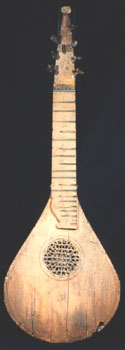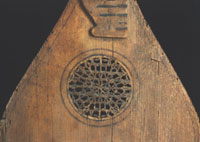6 Course Cittern by "A. Rossi Urbino," 16th Century.
Last updated
Sunday, April 02, 2023.
|
Return to Old Instruments Gallery |
Please note that all images here have been cropped and resized in order to be web-friendly. However, larger, uncropped, high-res images of the same can be had either by clicking on the image (to open in a separate browser window), or by right clicking and selecting "Save As" (to save to your computer).
Images |
|
||||
|---|---|---|---|---|---|
General Description |
This instrument was up for sale in the mid- to late-1990s. Its present whereabouts are currently unknown. The instrument is carved from one piece, except for the soundboard and fingerboard. It appears very similar to the cittern currently in Bologna. The instrument is currently in very poor condition. There is a large hole in one side and the comb is missing. |
||||
The words "A Rossi [da?] Urbino" and a date (possibly "1530" or "1550"?) are written on the neck near to the neck block and adjacent to the fingerboard. The word "URBINO" is also written on the peghead adjacent to the nut.
|
|||||
Body: Soundboard: Back: Sides: Fingerboard: |
|||||
Soundboard |
The soundboard is cracked in many places, and a section is missing on the lower right hand side of the soundboard. There is also a rather large hole in the right bottom/side of the instrument below the missing piece of soundboard. |
||||
Rose |
The rose is inset. It is carved from wood and does not appear to be backed by parchment, though it is backed by seven small bars, much as are lute rosettes. The design is unusual in that it appears to be neither exactly gothic or arabesque and resembles, rather, interwoven ropes. (See detail of the soundboard image, above.) | ||||
Pegblock |
|||||
Pegs |
Of the current pegs, seven of the pegs may be original and two are replacements. Three pegs are currently lost; two of them appear to be broken off inside the pegholes. (See detail of pegblock, above.) | ||||
Neck and Fingerboard |
As mentioned earlier, the side of the neck has a signature and what may be a date. It appears to read "A. Rossi da Urbino" followed by either the date "1530" or "1550," (see image under Provenance/Maker, above) but this has not yet been confirmed. |
||||
Fretting |
|
||||
Stringing |
The layout for the strings at the nut is currently a 6x2 configuration (see image under Provenance/Maker, above). | ||||
String Holder |
No string holder is currently on the instrument. The large hole both in and adjacent to the area of the string holder and the fact that the instrument is carved suggest that a comb was once there. | ||||
Footnotes |
|||||
How to cite this page: Hartig, Andrew. "6 Course Cittern by 'A. Rossi Urbino,' 16th Century." Renovata Cythara: The Renaissance Cittern Site. Ed. Andrew Hartig. 02 April 2023. 02 June 2025. <http://www.cittern.theaterofmusic.com/rossi.html>.










